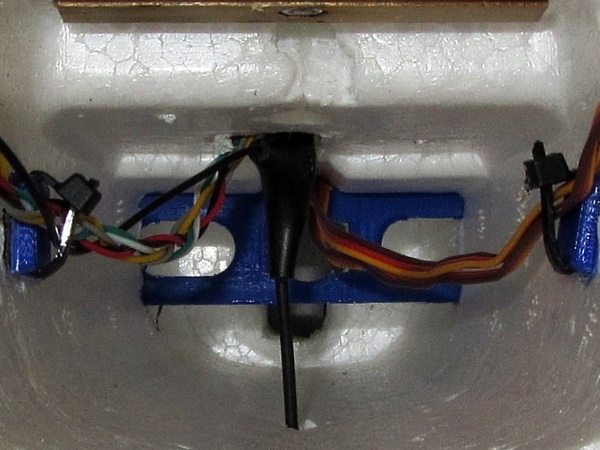X-UAV Mini Talon VTOL Project
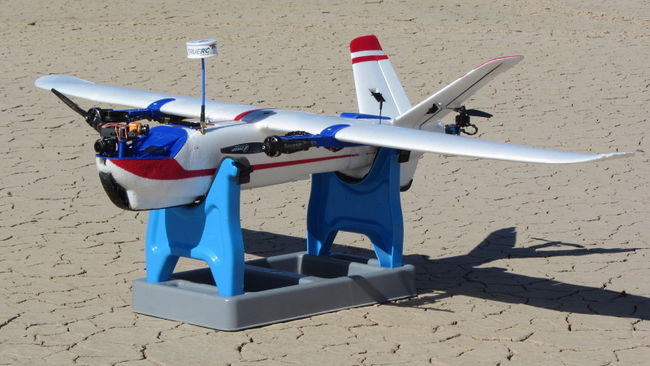
| |
| Ready for lift-off! |
Introduction
First, some acknowledgements-
Many thanks to ATX_Heli from RCGroups and the APM dev team, Greg Covey who did a really great write-up of his E-Flite Convergence conversion to APM andTridge, also from RCG and the APM dev team with his excellent write up on "Tiltrotor support for plane" and . Their combined help and write-ups were invaluable to this project!
My MiniTalon #4 was getting long in the tooth after nearly 2-1/2 years and hundreds of flights so I decided to use it as a test platform for this project. (Please see X-UAV Mini Talon Build Number 4 for any build information not found here.) I have been resisting doing a VTOL version of the Mini Talon because I knew it would be an all consuming project that would take some time. It has been!. It has also been a really fun and challenging project and hopefully the results will speak for themselves.
To begin, when I first started on this project I set up some simple design parameters to aim for:
- Relatively light weight - <1750g with a 5200/4S Lipo pack
- Minimum Carbon Fiber components - To keep any RF interference low
- Minimum add to frontal area in fixed wing flight - Keeps drag low
- Three-motor tilt rotor configuration - This should help with the weight
- Bolt-on rear motor mount - Keeps stock motor mount
- No additional booms or struts added to the fuselage (modified wings only)
- The ability to use the Matek F405-wing flight controller and all the flight control components already on the plane
So far nearly all of this has been achieved with only one small (4.2g) support bracket in the fuse and a little extra weight above my initial parameter (+20g)
Below are my build notes, print files and a flight review of this new Mini Talon configuration.
General Specifications
Initial Build
Seller - ReadyMadeRC, USA
Aircraft - X_UAV Mini Talon
Modification Date - October, 2019
Updates - 19 November, 2019
| Airframe Type - | Top Wing V-Tail FPV Specialist | All-Up Weight - | 62oz (1770g) w/ 4S/5200 Lipo Pack | |
| Wingspan - | 51 inches (1300mm) | Length - | 38 inches (965mm) | |
| Wing Area - | 3.23 ft^2 (30dm^2) | Wing Load w/5.2-4S - | 19.3 oz/ft^2 (59g/dm^2) | |
| Front Motors - | BrotherHobby 2806.5-1300kv | Rear Motor - | Cobra CPL2207-1800kv | |
| Front Propellers - | Graupner 8x5 E-Prop (4S) | Rear Propeller - | HQProp 6x4.5 Bull Nose | |
| *Lifting Static Thrust - | 3365g | *Forward Static Thrust - | 2744g | |
| Lifting Static Thrust:Weight - | 1.9 | Forward Static Thrust:Weight - | 1.5 | |
| Max Continuous Power (4S) - | 1175 watts continuous (4S) | Max Forward Flight Power - | 874 watts continuous (4S) | |
| Battery Type - | 4S1P 5.2Ah Multistar Lipo | In-Flight Battery Capacity - | 4400mah/10C (85%) | |
| In flight efficiency - | TBA | Flight Time - | TBA | |
| COG - | 60mm @ Wing root (Stock) | *Static Test Conditions | @ 2550ft ASL |
Components/Flight Gear
Power Set-up
To determine front and rear motor sizes I first looked at how the weight of the plane would be distributed with respect to the three lift points and a CG of 60mm from the leading edge. The image below shows the weight mapping for the current 1792g AUW:
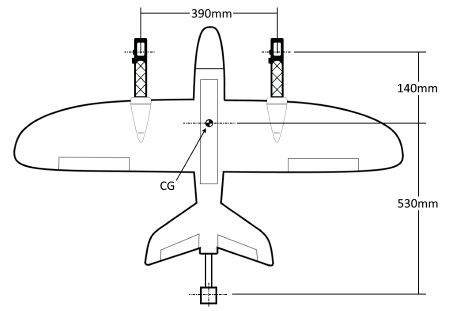
|
From this picture I determined the front motors need to lift 709 grams each and the rear motor, 374 grams for a theoretical stable hover. What I then did was look for motors as light as possible that could produce near these thrust numbers at 60% or less throttle.
With this information, I started with Racestar 2508-1275 motors on the front and a Cobra CPL2207-1800 motor on the rear. The Racestar motors worked well enough for my initial hover tests but I felt I needed a little more power and so they were replaced with Brotherhobby 2806.5-1300 units to get a bit more lift power and more headroom on the motor current.
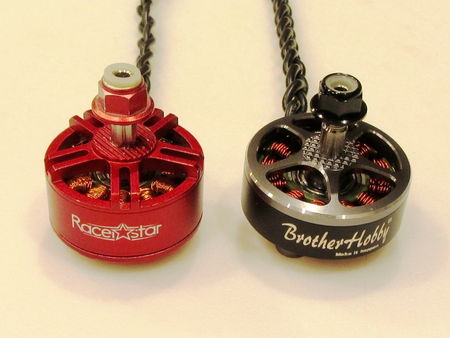
|
| Racestar 2508 and Brotherhobby 2806.5 |
On the rear motor, I started with a Cobra CPL2207-1800 which worked excellent but soon was made aware it is no longer available so I have replaced it here with an iFlight Tachyon T2207-1750 which I also run on my Strix Stratosurfer Twin.
For motor control I have chosen HGLRC Trex 60A, BLHeli_32 Opto ESC's with Active Freewheeling enabled. On all three motors I am using MR30, 3 pin connectors so they can easily be changed or reversed. Props were determined from bench testing with a 4S pack. The 8x5 Graupner front props are one of my favorite 8" Multirotor props and they also work extremely well on fixed wing.
Power Parts
- Front Motors - Brotherhobby Avenger 2806.5-1300kv
- Rear Motor - iFlight T2207-1750kv
- ESC - HGLRC T-Rex 60A BLHeli_32 ESC
- Left Front Prop - Graupner E-Prop 8 x 5 CCW
- Right Front Prop - Graupner E-Prop 8 x 5 CW
- Rear Prop - HQProp 6 x 4.5 Bull Nose-CCW
- Battery - Multistar 4S/5200, 10C, 438g
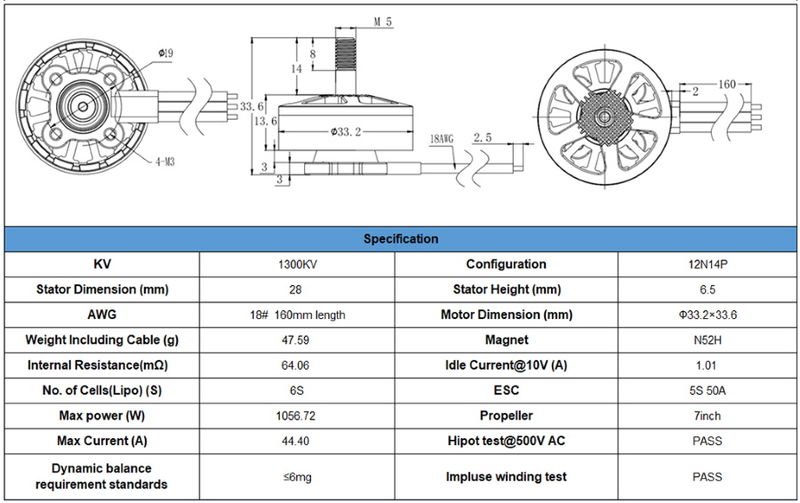
|
| Brotherhobby specification |

|
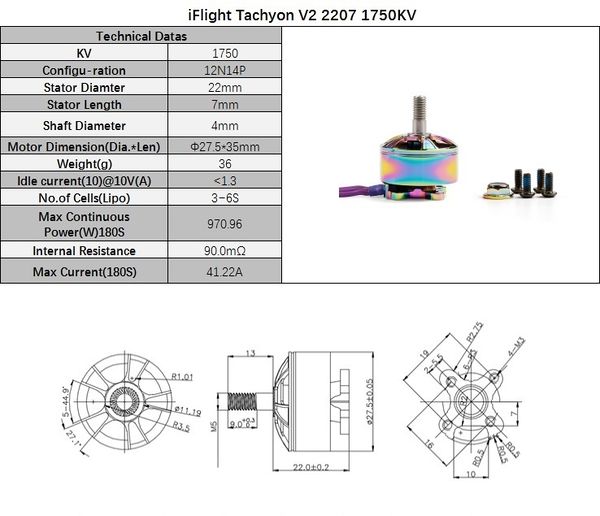
|
| iFlight Tachyon specification |

|
Servos
It is important to understand that the front tilt arms are designed to fit a TowerPro MG92B servo and while other servos may fit, they might not have enough torque and be robust enough for this job. The MG92B servos make 3.5kg*cm torque on 6v and they have all metal gearing with dual bearing support on the mainshaft. It is also important to note that TowerPro servos are widely counterfeighted so buyer beware and buy from an authorized site that guarantees original parts. I get mine from Grayson Hobby
When purchasing understand too there is a 360 degree robotic version of the MG92B servo. It is not a proportional servo (winch only) so it will not work. Here is a link to the TowerPro site for more information-
TowerPro MG92B Servo
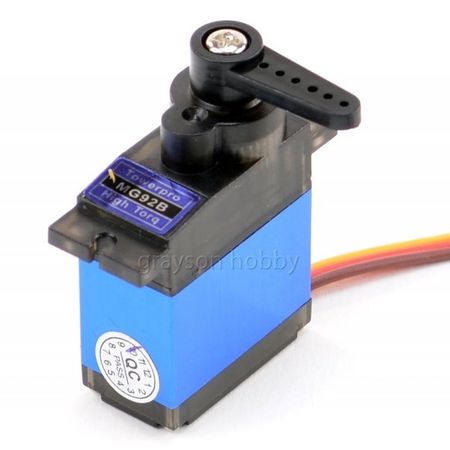
|
| MG92B Servo |
Front Motor Mount Evolution
This design had many revisions through the life of this project! Again my goal was to make it light, simple and strong.

|
While I won't show all the versions and revisions of the front mounts, below are a few:
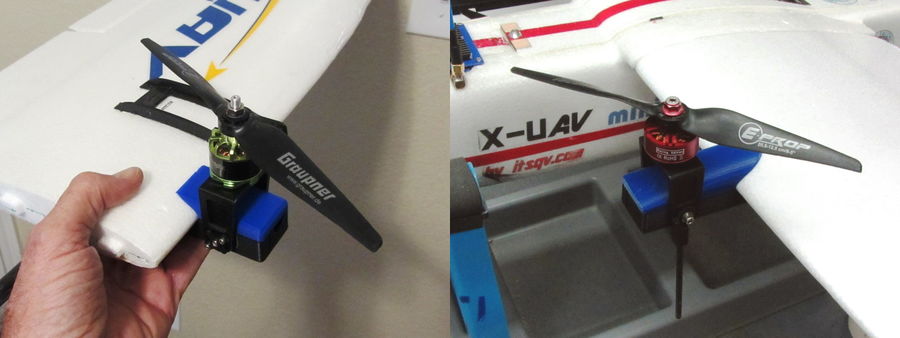
|
| Version 1/2 |
Version 3 was very similar with a stretched out mount. It looked nice but I felt it still blocked too much of the prop thrust.
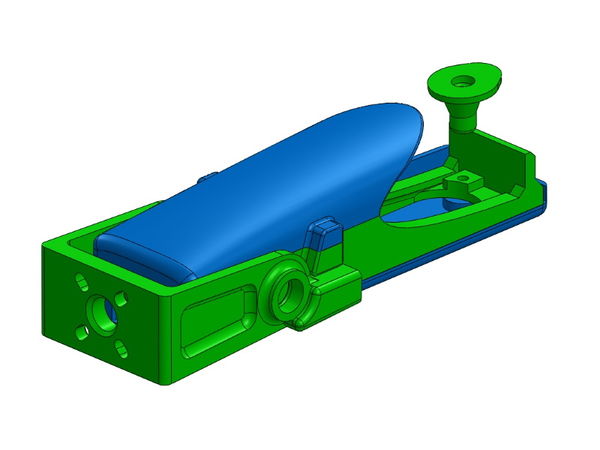
|
| Version 3 |
For a short time I considered an offset mount so that I could use a larger prop and not have the forward flight position too far forward. The problem with this idea is, I would need a much larger, more powerfull servo.
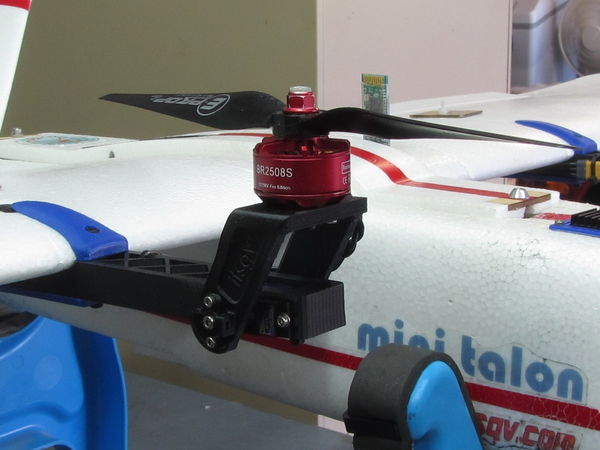
|
| Version 4 |
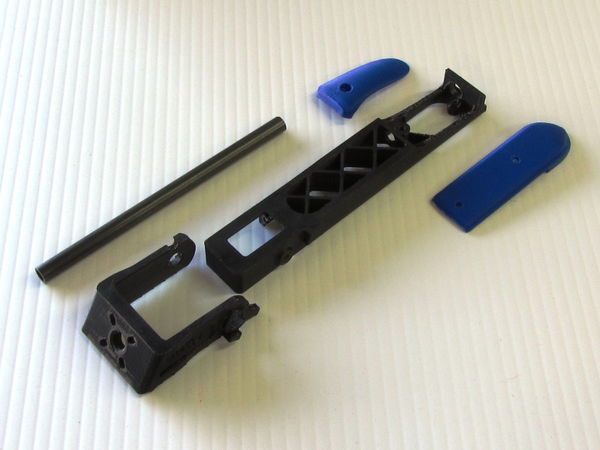
|
| Version 4 parts |
The first flight tested version (V6) used the main mount arm from V4 and a straight motor mount together with an 8mm x 135mm CF tube to get the moment forces spread across more of the wing.
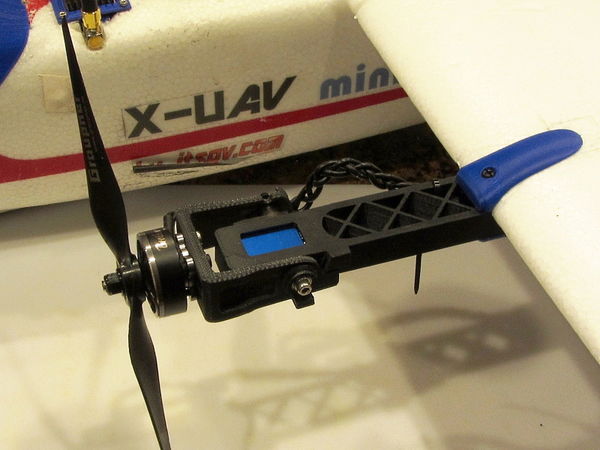
|
The latest version eliminates the need for the CF tube by using a longer arm that is ribbed to get the strength way up
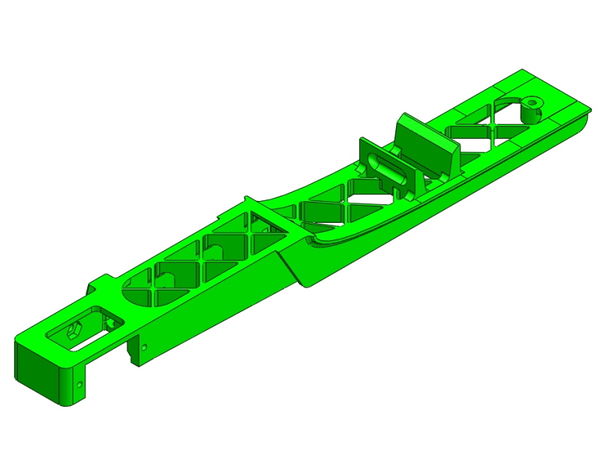
|
| Current arm design |
Front Motor Mounts Assembly
First - Glue!!
For this project I have used Gorilla Clear Grip Contact Adhesive which is very similar to E6000, UHU-Por and other thick flexible foam glues. Generally, E6000 is my favorite but it does soften the foam for the first few hours and can cause problems when parts need critical alignments. So I went with the Gorilla.
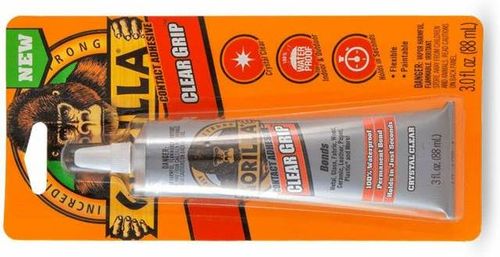
|
The front assemblies are not identical for the left and right wings. There are separate prints for left and right arms and left and right motor mounts. When mounted correctly, the servo opening faces in the direction of the wingtip as shown in the layout picture below. The main structure consists of a full length arm and a motor mount bracket which is supported by the servo on one side and a ball bearing on the opposite side. There is a bottom cover which hides and protects wiring and a top cover which helps secure the arm to the top of the wing.
Below is an image of the right side motor/arm assembly:
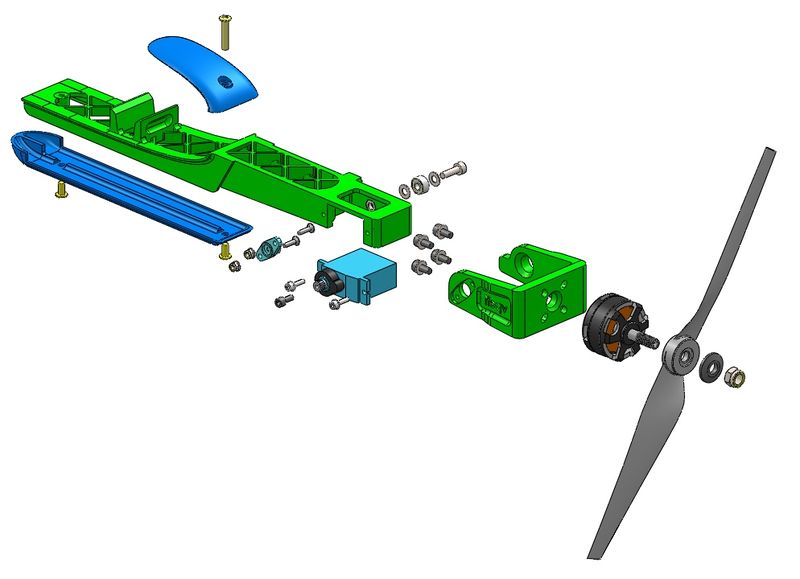
|
Complete parts list for one right front assembly:
| DESCRIPTION | QTY |
|---|---|
| Motor/Prop Assembly | 1 |
| TowerPro MG92B Servo | 1 |
| TowerPro Servo Arm (cut) | 1 |
| 693ZZ Shielded Ball Bearing, 3 x 8 x 4 | 1 |
| SHCS M3 x 6mm, Steel | 4 |
| SHCS M3 x 10mm, Steel | 1 |
| SHCS M2 x 10mm, Steel | 2 |
| FHMS M2 x 8mm, Steel | 2 |
| M3 Hex Nut, Steel | 1 |
| M2 Hex Nut, Steel | 2 |
| M2 Nyloc Nut, Steel | 2 |
| M3 Flat Washer, Steel | 6 |
| M2 Flat Washer, Steel | 4 |
| PHS M3 x 6mm, Nylon | 2 |
| PHS M3 x 10mm, Nylon | 1 |
| 52227, VTOL Right Front Arm, 80mm | 1 |
| 52229, VTOL Right Motor Mount Bracket | 1 |
| 52222, VTOL Front Lower Cover | 1 |
| 52223, VTOL Front Upper Cover | 1 |
After printing the arm, install the two M2 and one M3 nuts into the holes in the servo bay. If the nuts seem tight, heat them up with a lighter before pushing them into position. Next, tap the two cover mount bosses to M3.
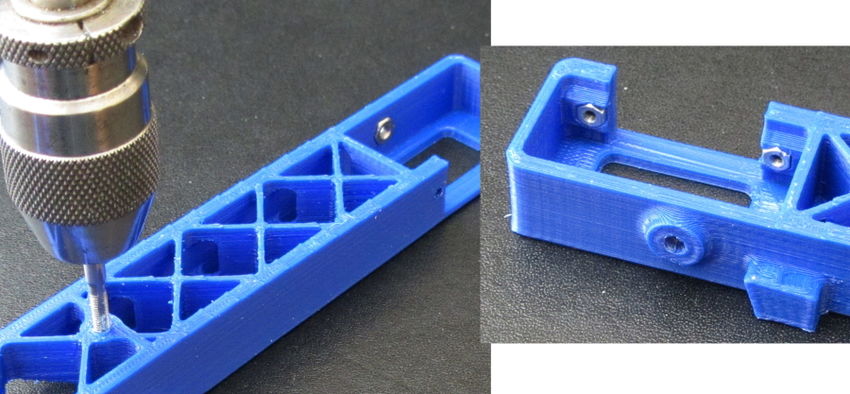
|
| Arm prep |
The arm is glued into the position shown in the picture below. Be careful to get the 90° angle correct and also that there is no "twist" relative to the leading edge.
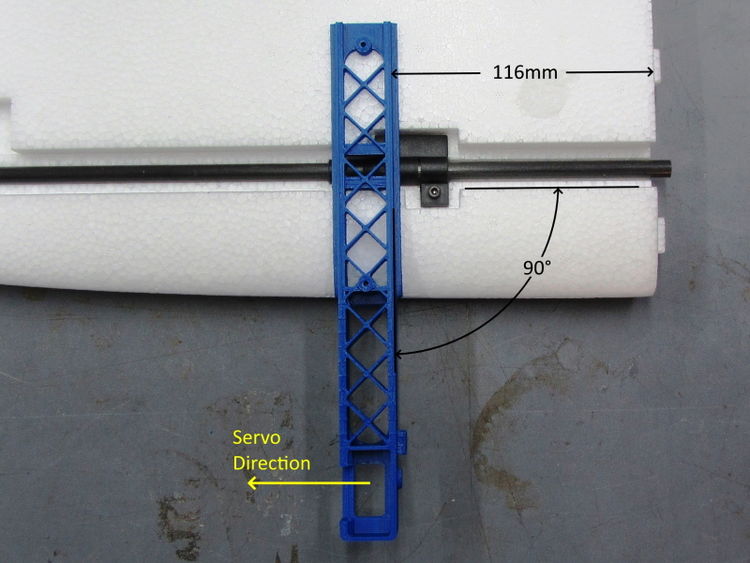
|
| Wing layout |
After Printing the motor mount, clean up the servo side hole with a 7mm drill bit and the bearing hole with an 8mm drill bit. This should be done by-hand and not with a power drill. The bearing should push into the hole with a small amount of resistance, if it is too tight it could potentially split the part so use the drill to ream it out until it is just a light push fit.
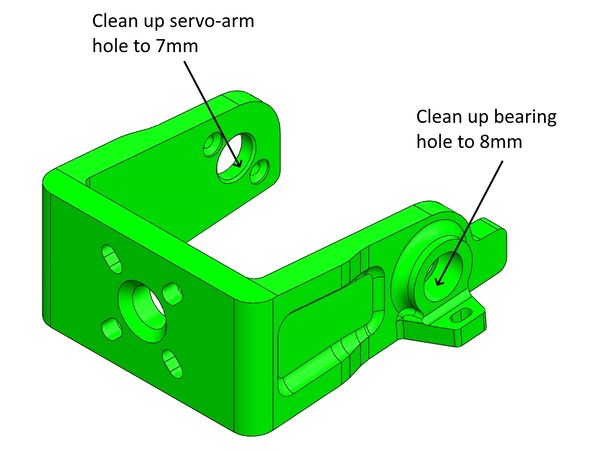
|
| Motor mount prep |
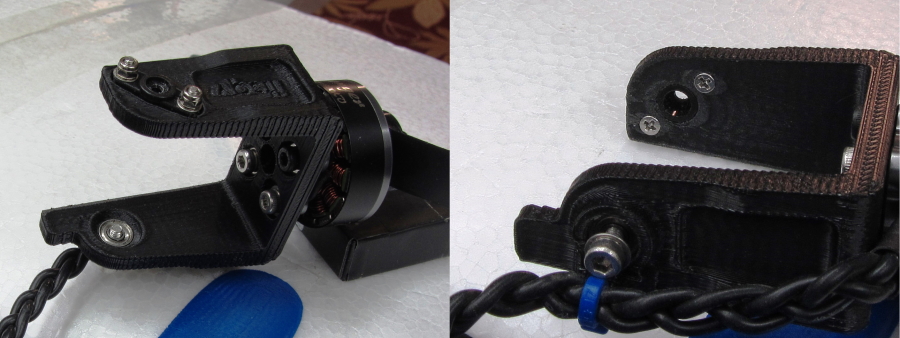
|
| Mount details |
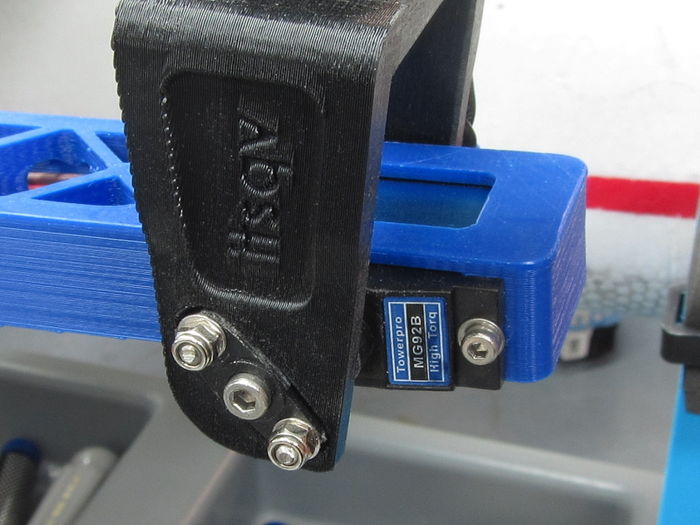
|
| Tilt up detail |
Using the assembly image, install all the parts onto the arm.
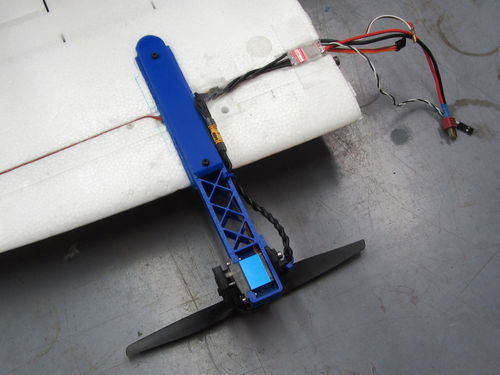
|
| Mounted! |
Rear Motor Mount
For the rear mount I wanted to keep it simple, light weight and easy to install using the stock rear motor mount.
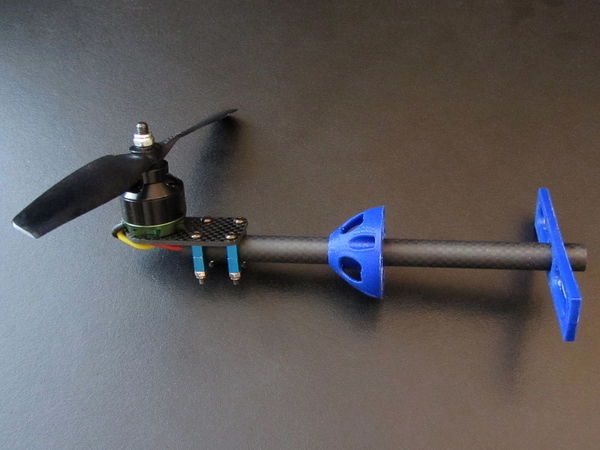
|
| Rear mount assembly |
Rear Motor Mount Assembly
The rear motor assembly consists of a CF boom tube, motor plate and two support pieces to hold the boom. The front support is cut and glued into the fuselage at a distance of 110mm to 115mm from the rear edge of the fuselage. One side of this bracket is flanged so a little inlay work should be done to keep it flush. The top of this bracket is flush against the roof of the fuselage. The rear support bolts directly to the motor mount and will fit mounts with 33mm to 34mm hole spacing. There are two holes for nylon anti-rotation screws that need to be tapped to M3.
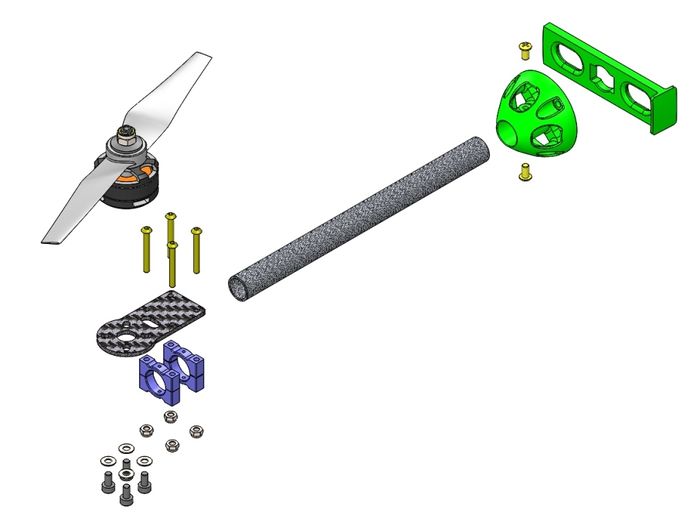
|
| Rear VTOL Assembly |
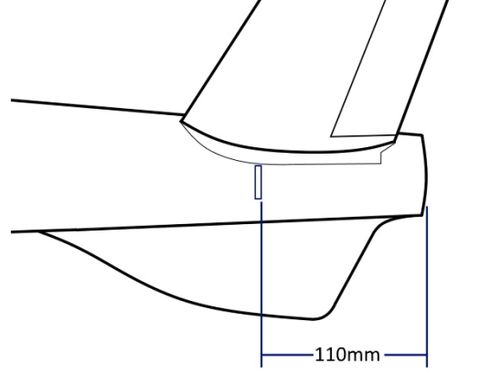
|
| Support bracket cut |
Rear mount assembly parts:
Below is a drawing of the motor plate I made from 2mm CF sheet. You could use 3mm plywood treated with thin CA or G10 fiberglass if CF sheet is not available. Your dimensions may vary depending on the hole spacing for the tube clamps you buy and the motor you elect to use.
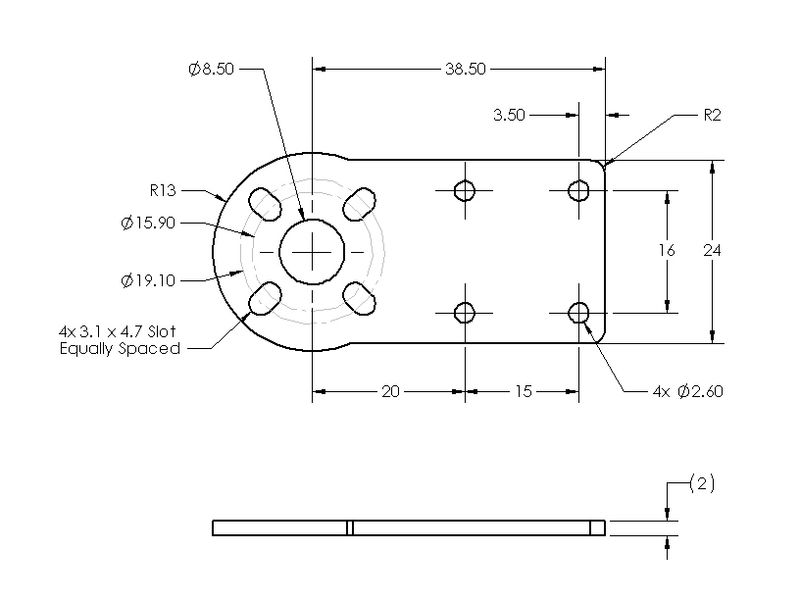
|
| Rear motor plate detail |
Project 3D Print Files
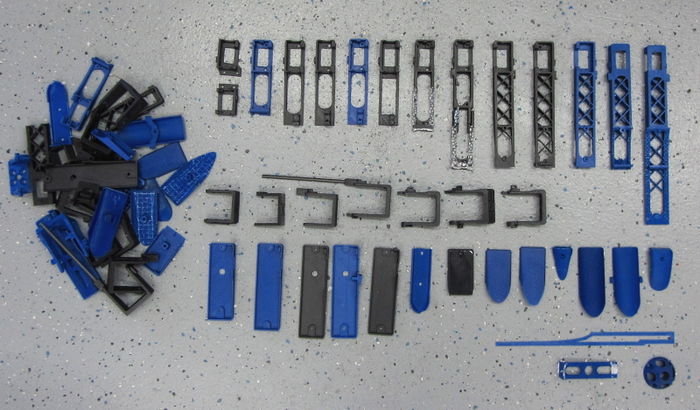
|
| LOTS of prototype pieces were done for this project!! |
All prints are setup with 40%-90% infill and a 0.8mm to 1mm shell thickness using Hatchbox ABS filament. Weights are shown as printed. See the bottom of this section for more print information.
| Image | Part Number | Part Description | Weight/Infill | Print File | Compatibility Notes |
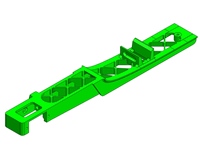
|
52226 | MT VTOL Left Front Arm 80mm | 15.7g/90% | 52226.STL | 80mm Left Front Motor Arm |
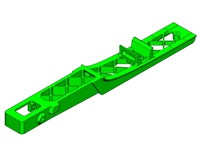
|
52227 | MT VTOL Right Front Arm 80mm | 15.7g/90% | 52227.STL | 80mm Right Front Motor Arm |
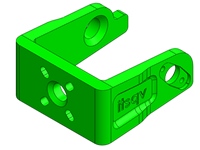
|
52228 | MT Left VTOL Motor Mount Bracket | 8.2g/90% | 52228.STL | Fits motors with 16mm to 19mm mount holes |
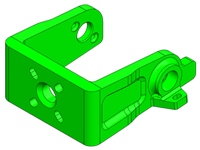
|
52229 | MT Right VTOL Motor Mount Bracket | 8.2g/90% | 52229.STL | Fits motors with 16mm to 19mm mount holes |
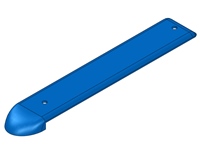
|
52222 | MT VTOL Front Lower Assembly Cover | 3.4g/40% | 52222.STL | Wiring cover for the front wing mount |
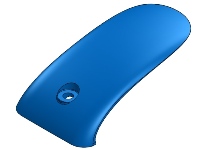
|
52223 | MT VTOL Front Upper Assembly Cover | 2.2g/40% | 52223.STL | Clamping cover for the front wing mount |
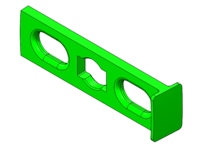
|
52224 | MT VTOL Rear Motor mount Forward Support Bracket | 4.2g/80% | 52224.STL | Front support for the 12mm CF tube |
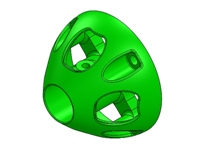
|
52225 | MT VTOL Rear Motor Mount Support | 5.3g/75% | 52225.STL | Rear support for the 12mm CF tube UPDATE - Fits 33mm & 34mm mounts |
Print Recommendations
Below is a list of the parts with some print parameters I used. All prints for this project were printed using Hatchbox ABS filament and all prints should load automatically in the correct orientation.
- Front arms are printed upside-down with support fill. Main part infill is 90% - 100%, support is 24% and support type is "Everywhere".
- Motor mounts are printed with the bottom edge against the print platform, Do NOT print these with the motor face down. Quality should be .1mm to .2mm, speed - slow and main part infill 90% - 100%. Support should not be needed.
- The front top cover is printed with the forward plate against the print platform. Main part infill is 40% or more for strength.
- The front bottom cover is printed with the flat side down. Main part infill is 40% or more.
- The rear-mount forward bracket is printed with the bottom edge down. Infill is 50% or more.
- The rear-mount rear support is printed with the motor face down. Infill is 75% or more.
Flight Control
For flight control I stayed with the Matek F405-wing with Arduplane/Chibios firmware running with Q_Plane parameters enabled. For the initial vertical flight test I ran it with all default parameters on the flight control parts. The only adjustments (to the parameters) were the motor tilt angles needing to be set-up at 0 and 90 degrees. For the first flight shown in the Transition video, I changed the parameter which controls pitch trim between vertical and forward flight, a couple of recommended yaw parameters and I added a little expo to my transmitter to soften up response during vertical flight.
Of course with adding two motors, two servos and a mag compass there are a few more wires to deal with! The Matek board does a great job in keeping the wiring simple and manageable.
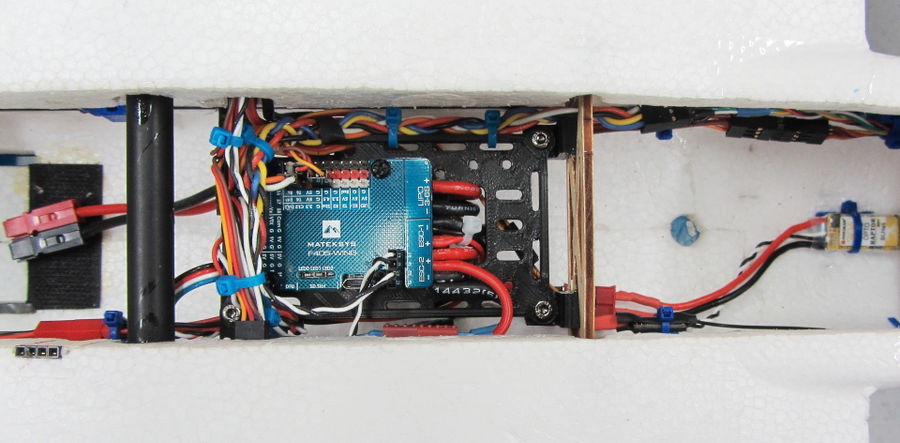
|
Below are the Matek board pin-outs I used, what they are connected to and any APM parameter change made to get the assignment correct.
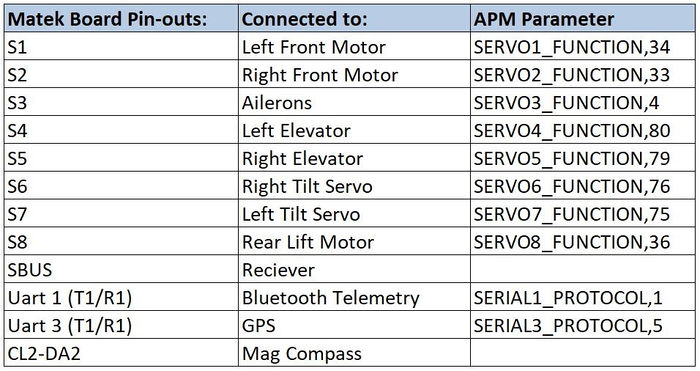
|
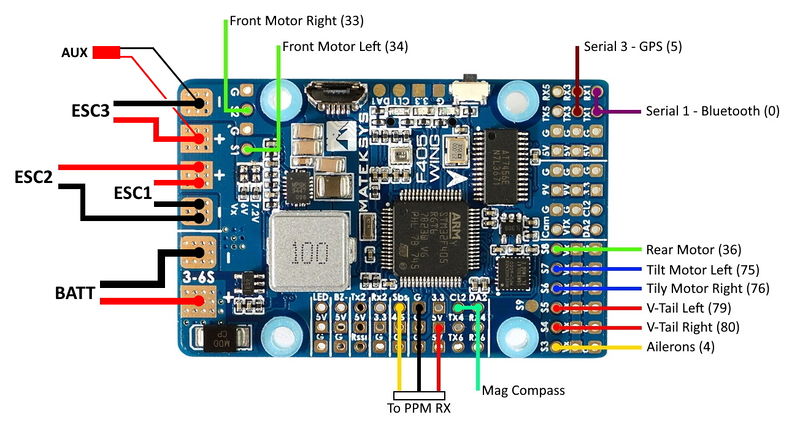
|
APM Parameter Changes
I assume anyone following/copying this build knows something about APM and how to set-up parameters for normal fixed wing flight. If you have no experience with APM, it may seem overwhelming so take your time and ask a lot of questions! A great place to get questions searched and answered is the RC-Groups thread for Arduplane/Chibios.
RC-Groups Thread - Most Integrated Ardupilot Flight Controller (ChiBios)
Another great place is the Arduplane Wiki which can be found on the ardupilot.org site. Here are a couple key pages:
With that, below are two lists of some of the parameters I changed to get the results I wanted. The first list shows some of the standard parameter changes made to help with safety and stability. Pay attention to the flight mode list as it is important you start out arming the plane in QSTABILIZE mode.
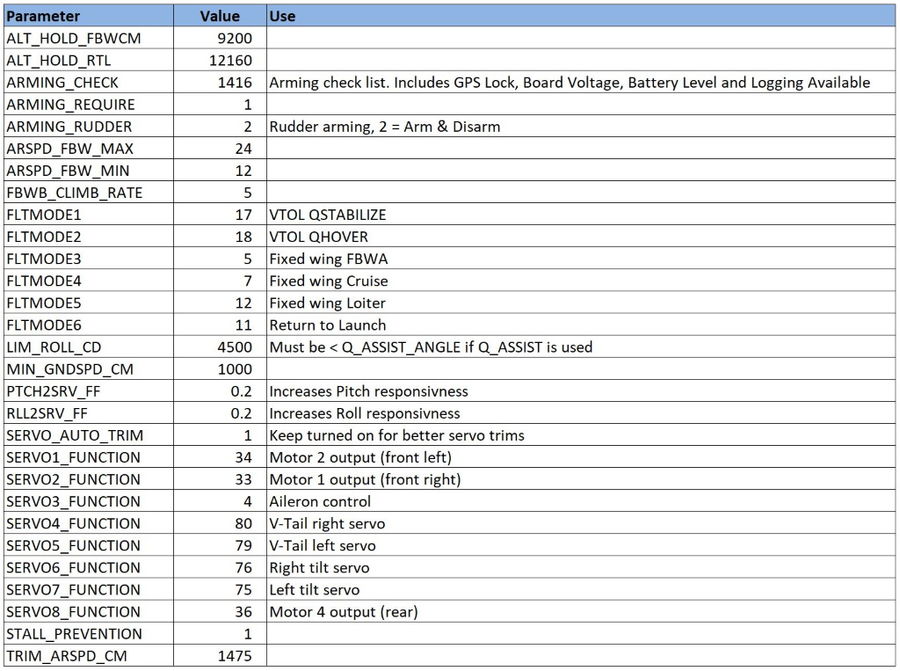
|
The second list shows changes I made to the Quadplane or "Q" parameters. A couple of important ones here are the Q_ASSIST angle and speed parameters. If you decide to use Q_ASSIST, which can help with plane stability in bad fixed wing attitude situations, it is necessary to make sure the Q_ASSIST_ANGLE is quite a bit more than the LIM_ROLL_CD (maximum roll angle) in FBWA. I have mine set at 10 degrees more. The Q_ASSIST_SPEED parameter should be less than your minimum flight speed, close to stall speed.
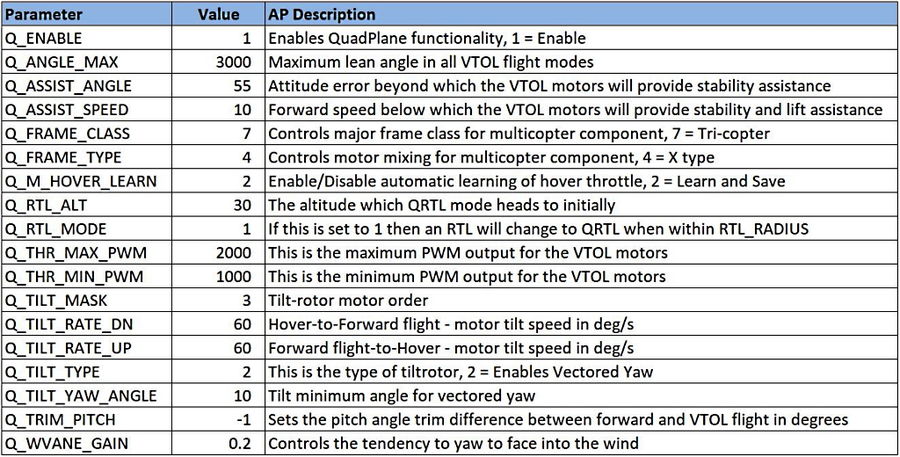
|
Tilt Set-up
NOTE: It is very important to get the vertical and forward angles adjusted correctly and matched from one side to the other. If there is any difference in angle while in forward flight, the plane will continuously roll. When switching from VTOL flight to forward flight each tilt is sent first to 45 degrees so if the forward and VTOL angles are not matched from side to side, the plane may roll violently on the transition.
To get the forward flight and vertical flight tilt angles dialed in, I used a pair of thin CF rods clamped to the prop face with a washer and nut then visually used these to get everything aligned side to side. For forward flight I set the plane level so that the wings had about a 2.5° angle of attack then trimmed the tilt servos for a 0 thrust angle. For the vertical flight I then leveled the plane so that pitch showed as zero in Mission Planner when in Q_HOVER mode (-2.5°) then trimmed each tilt servo to match a bubble level.
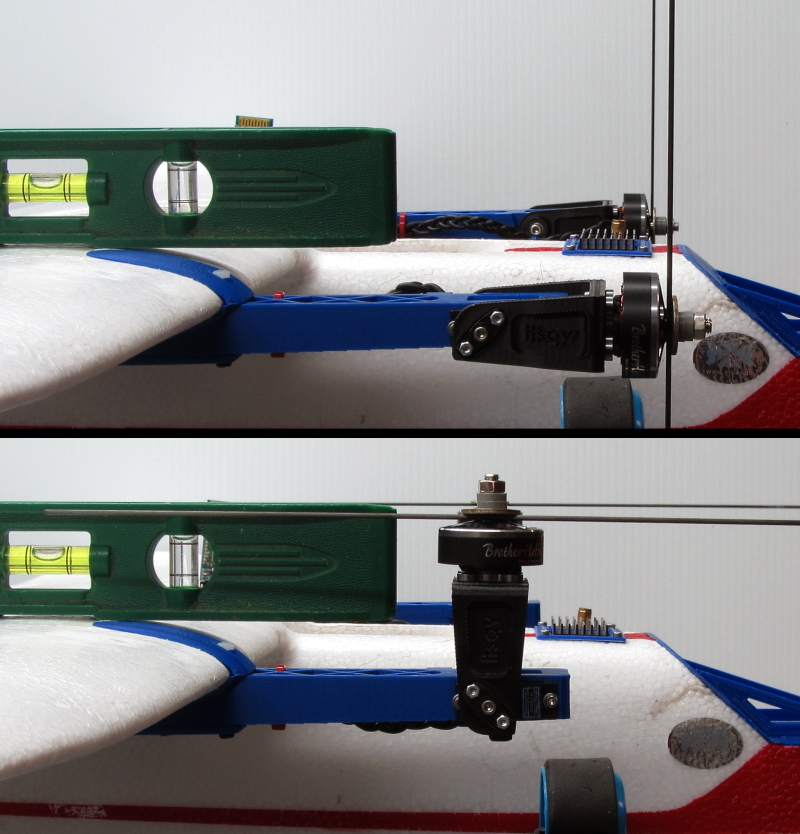
|
First Flights!
19 October, 2019
On my first flight, in a word AWESOME!! Going from a hover to forward flight was a little nerve racking but when I finally threw the switch it blew my mind how fast and stable the plane was. I threw the switch when the plane was at about 20ft altitude and then stood there in complete shock watching it effortlessly rocket away. In forward flight it is a little harder to turn sharply and this may be due to the position of the forward props and also I have the max-roll setting quite low in Arduplane. It flew very much like my last twin did so very stable and extremely quiet. It would cruise easily at ~4-4.2A although the plane speed was a bit low. I'll have to try some different props going forward.
Unfortunately, during this first flight, I never got to switch it back to hover mode because I wasn't paying attention to forward speed when I turned into the wind for a landing, I got impatient and cranked the rudder to turn more sharply and she snap rolled/tip stalled without enough altitude to recover. This would be unusual in any of my standard Mini Talons but such is flying :).
Anyway, even though I stuffed it, I'm extremely happy with how it performed and will get it back together very soon.
18 November, 2019
The video below is my 4th time out after learning a few new things about Arduplane quadplane set-ups. I can report the plane is fantastic in flight. As a plane it is (now) only slightly less responsive than a standard Mini Talon. In VTOL flight it flies like a solid (large) multirotor and it is amazingly stable. The transitions are now complete no-brainers and just wicked fun to watch!
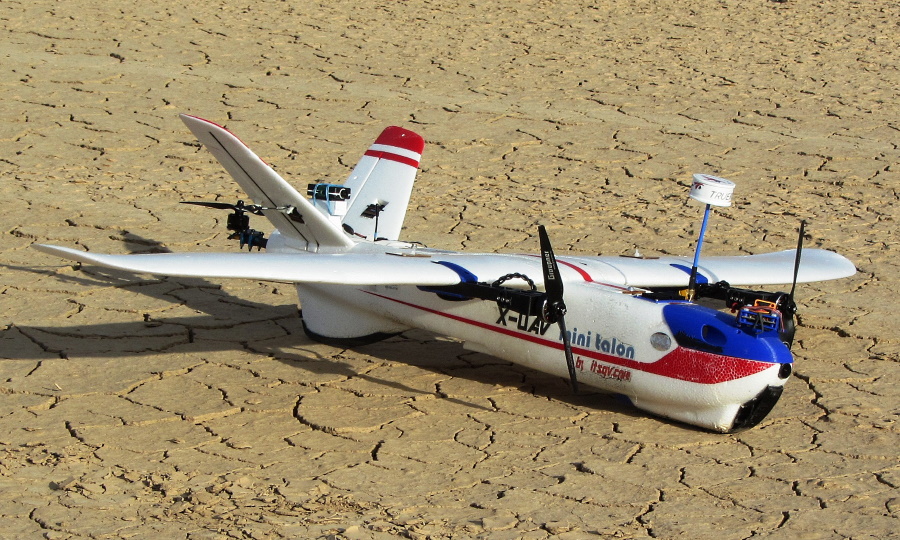
|
| Take-off ready! |
Video
|
Success! November 18, 2019 |
Parting Shots
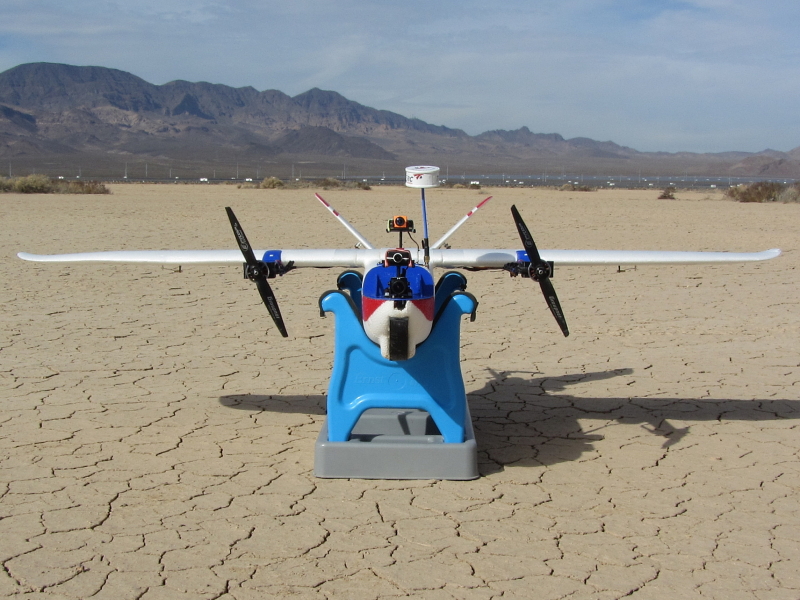
|
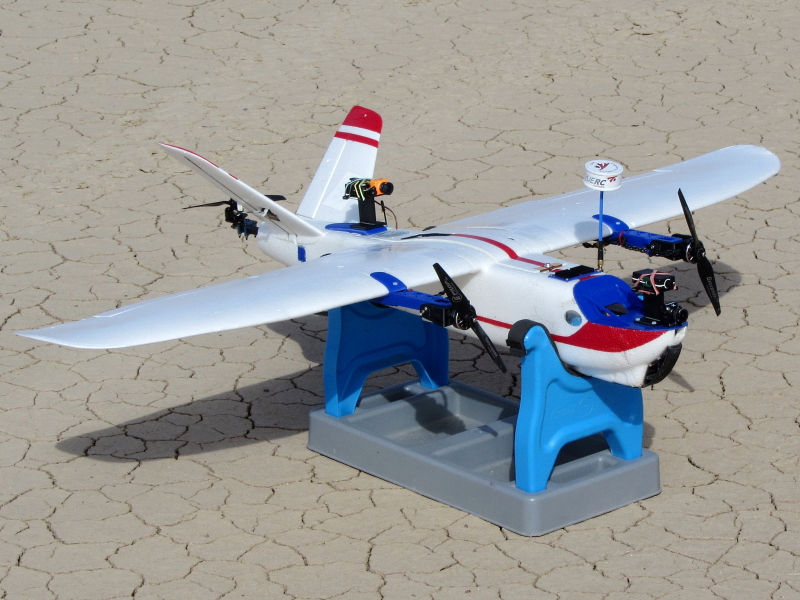
|
See Also
Some of the Vendors I used for this project
